13 Best Places to Visit in Bruges: What’s Worth Your Time (and What’s Not)

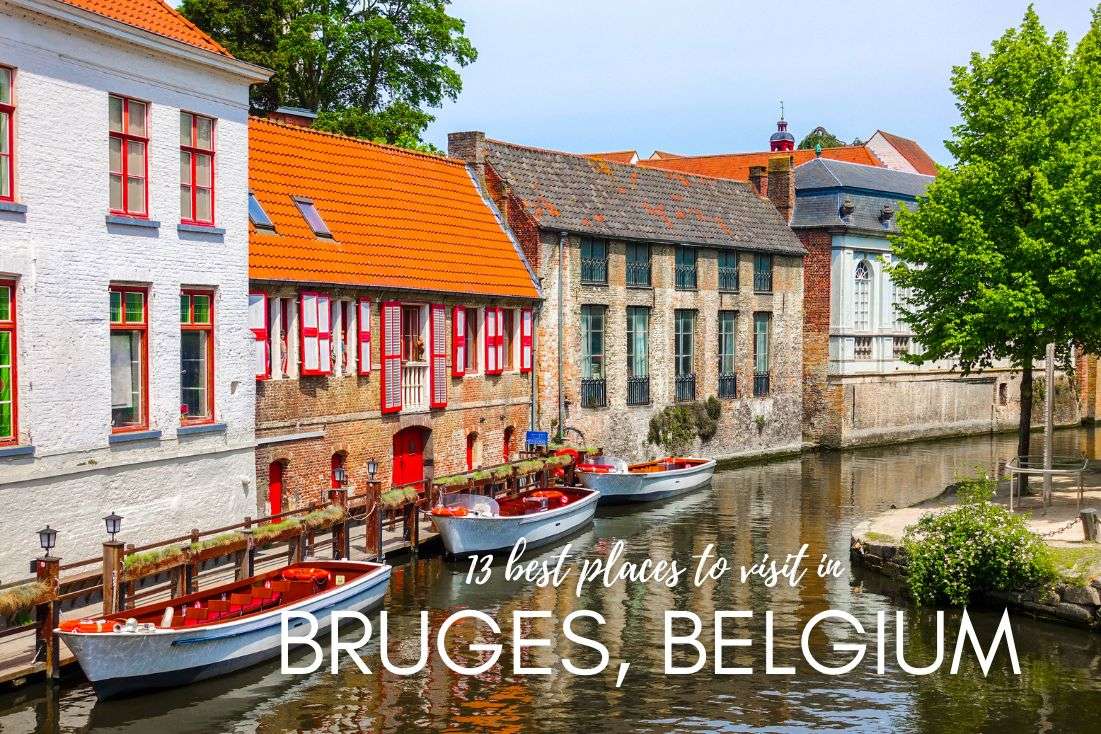
Quick list: the best places to visit in Bruges (at a glance)
Tourist map of Bruges attractions and train station
1. Bruges Beer Experience: My absolute favorite thing to do in Bruges
2. De Halve Maan brewery tour: Is Bruges’ oldest brewery worth the hype?
3. Bruges Belfry: Should you climb Bruges' most famous tower?
4. Basilica of the Holy Blood: What’s inside Bruges’ most mysterious church?
5. The churches of Bruges: Is this the most beautiful church in Bruges?
6. Market Square, Burg Square & Bruges City Hall: What to see in Bruges’ city center?
7. Historium Bruges: Is this immersive museum worth your time?
8. Choco Story Museum: Is this the best chocolate museum in Belgium?
9. Boat canal tour in Bruges: Is this a must-do in Bruges or a tourist trap?
10. Lovers’ Bridges: Where to find the most romantic places in Bruges?
11. Bruge windmills: The most photogenic things to see in Bruges without crowds
12. Groeningemuseum, Gruuthuse, or Sint-Janshospitaal: Which Bruges art museum deserves your time?
13. Underrated Bruges attractions: Are Bruges’ city gates and old bridges worth the walk?
Bruges travel tips: How to make the most of your day:
Looking for the best places to visit in Bruges? I’ve been there, walked the cobbled streets, eaten the waffles, climbed the towers (well, tried), and squeezed in as much as humanly possible—so you don’t have to. My guide includes only the best spots and no tourist traps (well, maybe one or two, but at least I’ll warn you and explain why I mention them).
Bruges—aka Brugge if you're feeling Flemish—is tiny, flat, and ridiculously scenic. And super crowded with tourists. The entire historic center is a UNESCO World Heritage site, and everything you’ll want to see is packed into a walkable 3x2 km loop.
That means you can visit the Bruges Belfry, sip beer at De Halve Maan, float past medieval buildings on a Brugescanal tour, and even catch a glimpse of Michelangelo’s work in the Church of Our Lady—all in one day, if you plan it right.
This article covers the top Bruges attractions, fun things to do, and hidden gems, based on real experience.
Start with the quick list below or keep scrolling to dive into what to visit in Bruges—and what you can skip.
Read more from my Belgium travel blog.
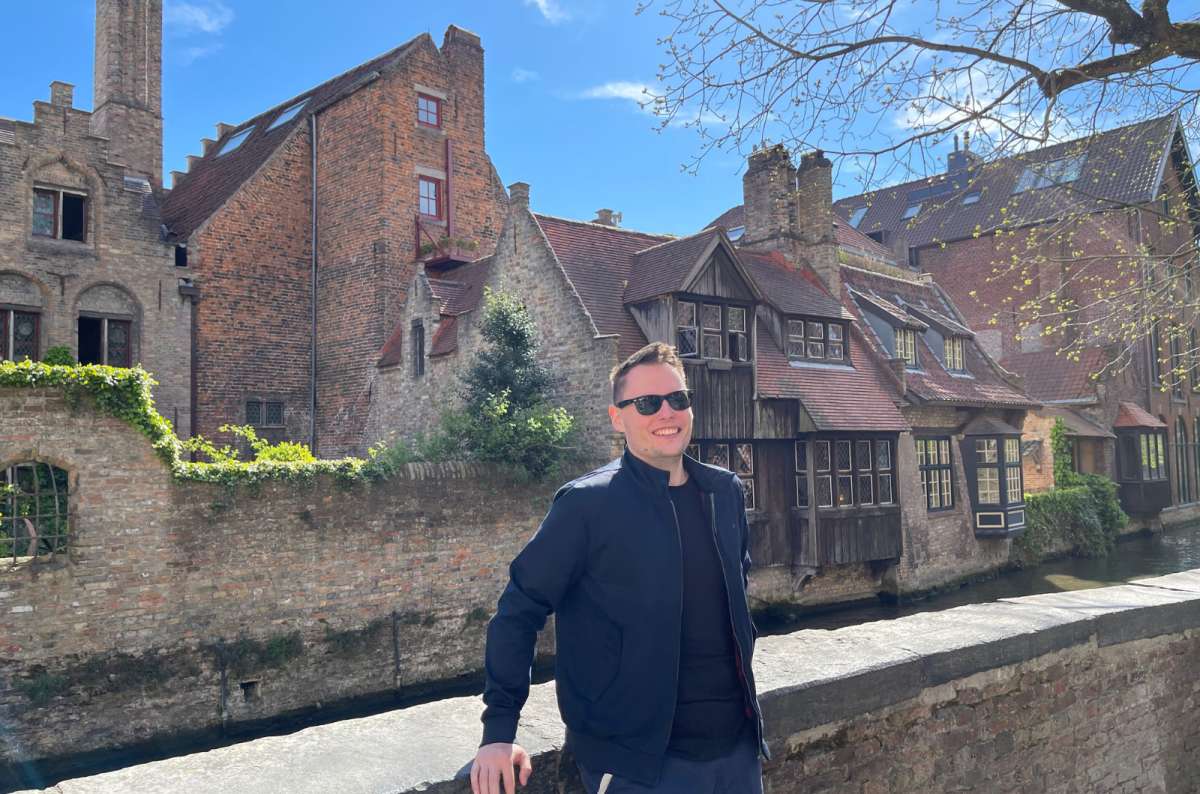
One of the most picturesque corners of the city—this charming canal view is a classic highlight on any list of what to see in Bruges
Sometimes, all you need to do is take the first step... I've filtered out the best hotels in Bruges for you
Save it for yourself to come back to later, or share with your friends on social media!
I've already planned your ititnerary for the trip, complete with my travel tips.
Quick list: the best places to visit in Bruges (at a glance)
- Bruges Beer Experience—An interactive, self-guided museum that turns you into a beer nerd.
- De Halve Maan Brewery Tour—A historic brewery with rooftop views and a beer pipeline.
- Bruges Belfry—Climb 366 steps for the best panoramic view in Bruges—if tickets aren’t sold out.
- Basilica of the Holy Blood—A tiny church claiming to hold a relic of Jesus’ blood.
- Church of Our Lady Bruges—A must-visit place in Bruges with a sky-high tower and a Michelangelo sculpture.
- Market Square, Burg Square & City Hall—The beating heart of the city and home to Bruges’ most famous facades.
- Historium Bruges—A high-tech time travel experience, right on Grote Markt. Bonus: beer at the end and another tower with a view.
- Choco-Story Museum—Learn and taste your way through the story of Belgian chocolate.
- Bruges Canal Tour—Tourist cliché? Yes. Still one of the most scenic things to do in Bruges? Absolutely.
- Lovers’ Bridges—Two of the most romantic photo spots in Bruges with bonus promise of eternal love.
- Windmills of Bruges—A quiet walk to four surviving windmills. Photogenic and pleasantly crowd-free.
- Bruges Art Museums—From Flemish masters to old surgical tools—Groeningemuseum, Gruuthuse, and Sint-Janshospitaal.
- City Gates & Historic Bridges—Underrated Bruges attractions that are easy to enjoy while strolling the outer green belt.

Tourist map of Bruges attractions and train station
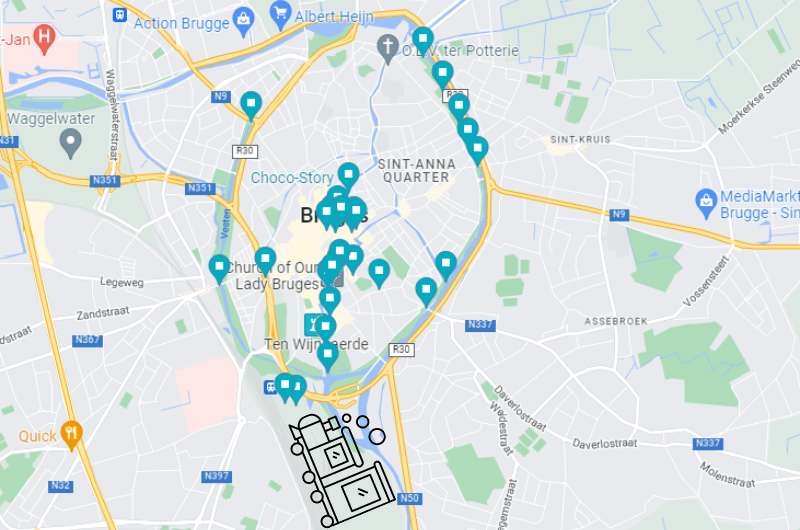
Everything you’ll want to visit in Bruges is in the city center. The train station is at the very bottom. Click through the map to the list of highlights in Google Maps.
So, what are the top things to do in Bruges, based on my own experience? (Take a look at my 1-day Bruges itinerary if you’re looking for a step-by-step plan)
1. Bruges Beer Experience: My absolute favorite thing to do in Bruges
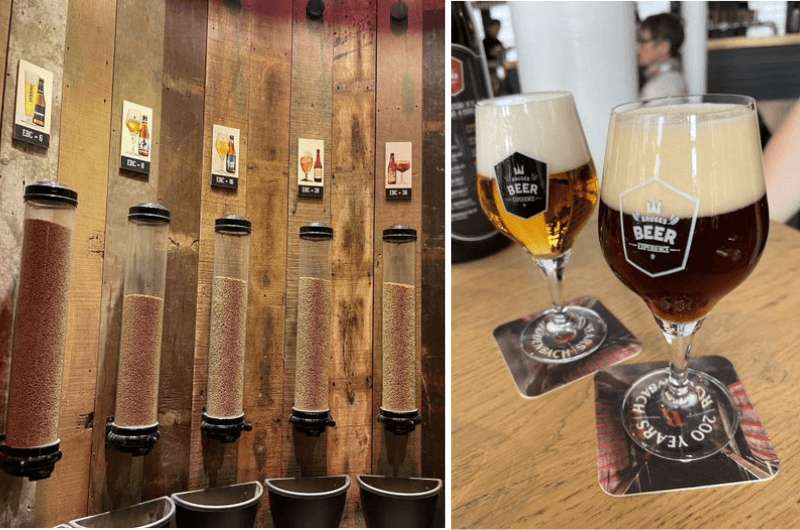
Left: Smell some hops and become a beer expert! Right: Taste some beer and become a beer expert! @ Bruges Beer Experience
Visitor information:
- Price: EUR 14, or EUR 20 with beer tasting at the end
- Opening hours: Daily 10 pm–6 pm (last entry at 5 pm), bar and shop close at 6:30 pm
I love beer, but I promise I’m being objective when I put two beer tours as my top two things to do in Bruges. They really are that great!
The Bruges Beer Experience is self-guided, fabulously interactive, and fun. We got a tablet and headphones and took 3 hours to walk through—and never once was I bored It does an excellent job telling you the story of beer, its history, production, and how it was perceived in different countries. There is even a kid’s version available.
We learned about the incredible number of beer types, leading to an entirely different beer culture in Belgium. The beer in Belgium is what wine is in other countries—a high-end beverage that gets paired with chocolates, cheeses and Michelin restaurant dishes! Now that’s my type of dining!

At the end of the tour, we did a tasting of 3 (strong!) beers.

My idea of interior decorating
2. De Halve Maan brewery tour: Is Bruges’ oldest brewery worth the hype?
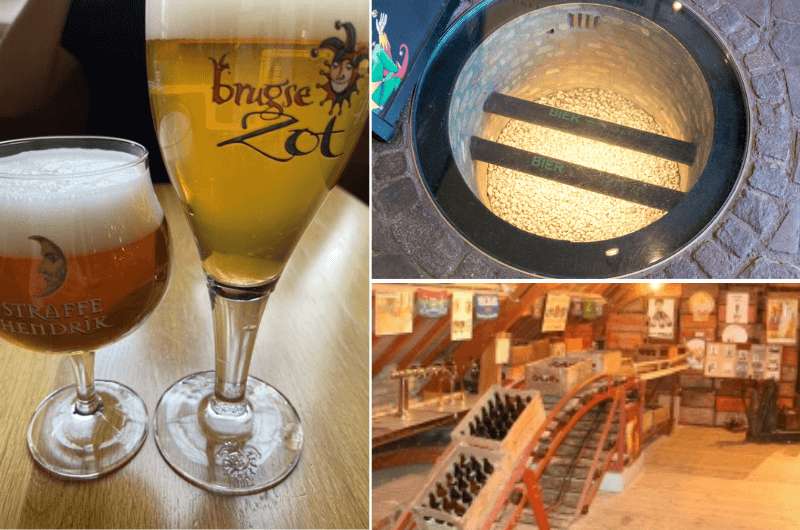
The unfiltered Brugse Zot, the beer pipe and part of the brewery tour
Visitor information:
- Price: EUR 16 for the 45-minute tour
- Opening times: Tours in English run 4x a day between 12 pm and 4:30 pm (time the last tour starts)
De Halve Mann (“The Half Moon”) is the only brewery that has managed to stay in central Bruges—everyone else moved their production of town. As such, it is in a historical building with historical building smells, narrow winding staircases, and old production secrets waiting to be told.
What is the brewery tour like?
We took a 45-minute tour through the brewery to learn some of them. Interestingly, the Halve Maan brewery built a separate bottling plant 3 km away—and so they had to get creative. We thoroughly enjoyed the tour. Our guide was entertaining and informative at the same time. The tour ends on the brewery roof where you get not only a free beer, but a fantastic view of Bruges, and—you guessed it (if you read the previous item on the list)—the Belfry.
The unfiltered Brugse Zot can only be bought at De Halve Maan brewery. It was fab.
There’s a gift shop and restaurant on site as well.
Book in advance. There are 4 English language tours per day.
A very unique thing to see in Bruges: a beer pipeline
In 2016, thanks to crowdsourcing, a one-of-a-kind, 3.2 km (2 miles) beer pipeline connecting the brewery and the bottling plant was built. You can see the pipeline at the entrance to the brewery.
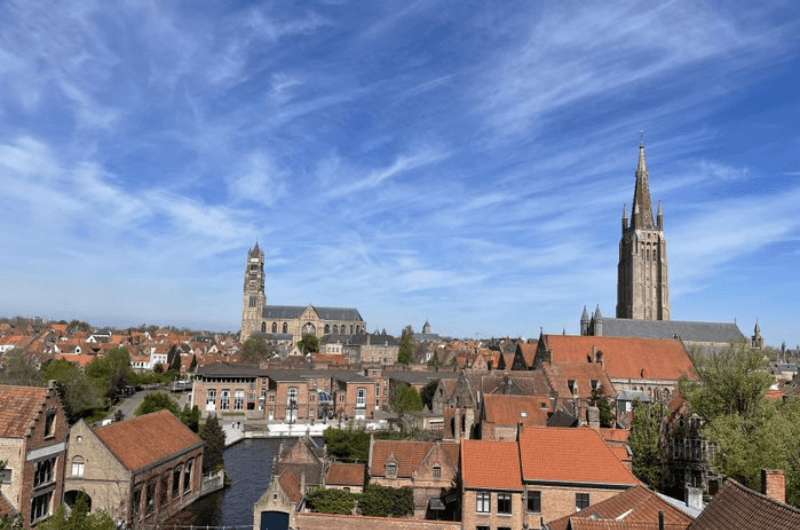
The views from the brewery rooftop

3. Bruges Belfry: Should you climb Bruges' most famous tower?
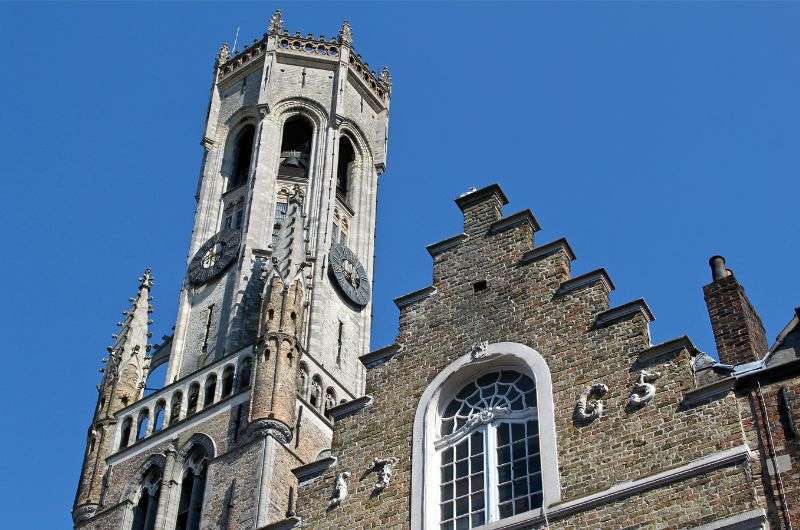
Buy your tickets to the Belfry in advance! They were sold out when we visited and we didn't get to go up.
Visitor information:
- Price: EUR 15, get tickets in advance!
- Opening hours: Daily 9 am–8 pm (varies in the winter months)
When you visit the Belfry in Bruges, you’ll need to walk up 366 stairs, but you’ll be rewarded with views of Bruges and beyond. I can imagine it’s stunning… You don’t want to miss this highlight of Bruges… but I did! It's one of the most iconic answers to the question, 'Bruges: what to visit first?'
Tickets sell out fast, so make sure to buy them in advance and then be there for your time slot! I, unfortunately, wasn’t so lucky and had to just stare at it from Grote Markt.
You can break up your trek up the tower in the treasury and then the carillon, which has a total of 47 bells.
Make sure you hear the bells play on Wednesdays, Saturdays, and Sundays from 11 am–12 pm. And in the summer (June to September), they have an extra evening show on Mondays and Wednesdays around 8–9 pm.
4. Basilica of the Holy Blood: What’s inside Bruges’ most mysterious church?

The outside of the basilica is more interesting than the inside. I’m not even going to mention the stained cloth that is supposedly holy.
Visitor information:
- Price: EUR 5 for museum, rest is free–donations encouraged
- Opening hours: Daily 2 pm–4 pm and Fridays 10:15 am–11 am if you want to see the vial with the blood-stained cloth; the basilica is open daily 10 am–5:15 pm
I found the Basilica of the Holy Blood interesting mainly because it’s unlike any other church I’ve ever visited—it’s not free-standing. It’s unique because it’s built into the corner of the Burg Square, attached to what used to be the old residence of the Count of Flanders.
It’s small, but it has a big claim to fame—it holds a relic (a piece of cloth) that has Jesus’ blood smeared on it. Or so they say.
The basilica itself has two stories, but to be honest, it’s actually more beautiful from the outside.
How to see the holy relic in Bruges
You can come see the holy blood cloth that is housed in an ornate glass vial for free dailyfrom 2 pm to 4 pm. Additionally, on Fridays (and the first Sunday of the month), there's an extra morning session from 10:15 am to 11:00 am.
Fun fact: The blood used liquefy every Friday (or so they believe)...until it stopped and now it’s just a speck in a vial.

5. The churches of Bruges: Is this the most beautiful church in Bruges?
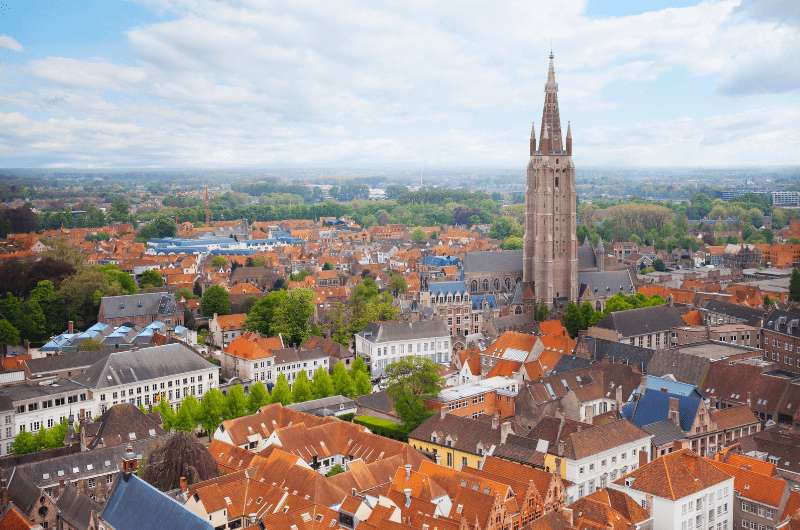
I’m not lying when I say that the tower is high @ Church of Our Lady Bruges
There are many churches in Bruges, but to me, they all start looking the same after the third one. Here are the ones that stood out to me when I visited Bruges:
Church of our Lady Bruges: a must-visit place in Bruges
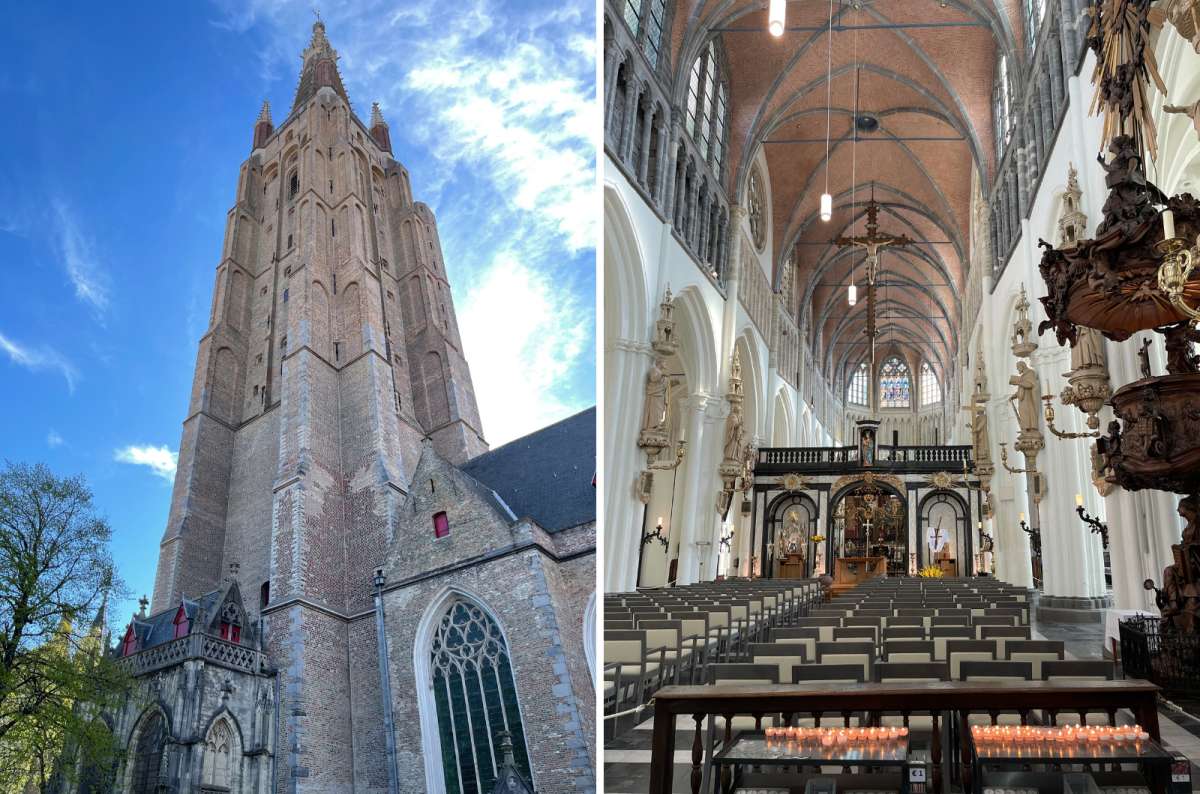
The Church of Our Lady is definitely a highlight on any list of what to see in Bruges
The Church of Our Lady Bruges has an incredibly high tower—you can’t miss it. Inside, you get medieval vibes, the only original Michelangelo statue outside of Italy, and various art pieces that also have English signage. There are also tombs you can visit.
Visitor information:
- Price: EUR 8, also available is a combination ticket for the Church of Our Lady and the nearby Gruuthusemuseum for EUR 17
- Opening hours: Daily 9:30 am–5 pm (opens at 1:30 pm on Sundays)
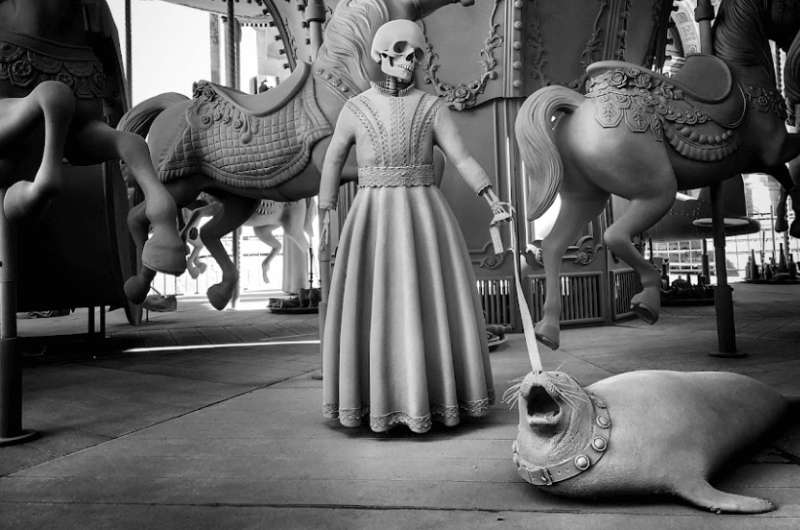
Just your typical carousel @ Sint-Walburgakerk. No living creatures allowed.
Other churches in Bruges that are worth visiting:
-
There’s the Sint-Salvatorskathedraal, which is nice, very large, and honestly feels a bit empty inside. I can imagine it’s impressive if you catch an organ concert.
-
The Heilige Magdalenakerk is nice, tucked in a quiet park near the canals—more peaceful than impressive.
-
The Sint-Walburgakerk is nice in that brooding, baroque kind of way, and bonus: it has a bizarre skull-covered white carousel thing outside.
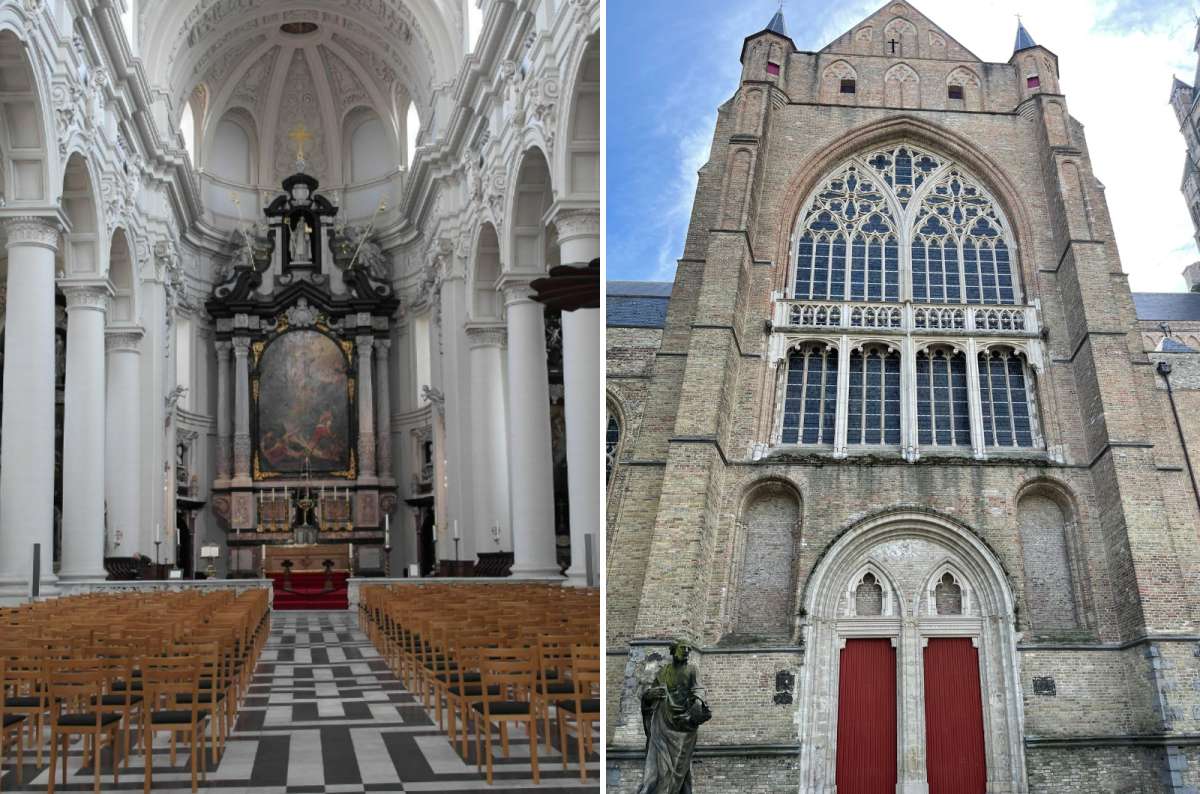
Baroque elegance meets medieval grandeur—St. Walburga’s Church and Saint Saviour’s Cathedral are two of Bruges’ finest landmarks
6. Market Square, Burg Square & Bruges City Hall: What to see in Bruges’ city center?
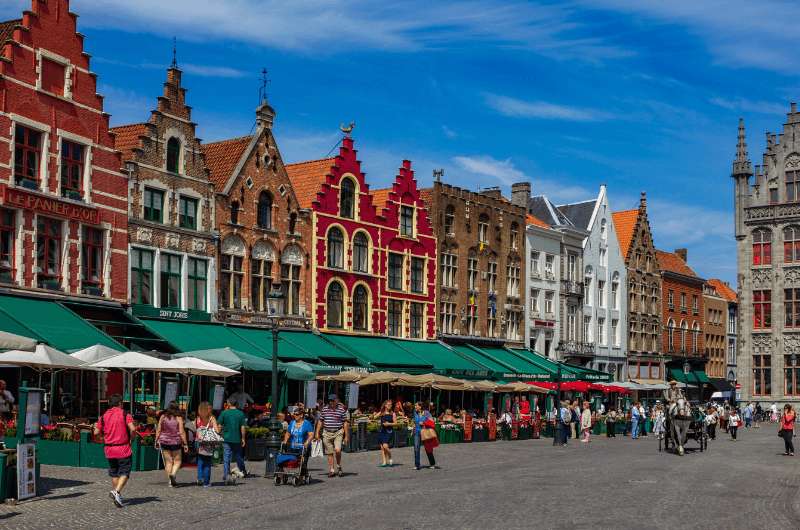
Grote Markt delightfulness
Some of the must-do places to visit in Bruges are the city’s squares and colorful buildings. Get transported back in time and admire the fairytale architecture in Bruges, sometimes dating back to the 13th century.
The must-visit place in Bruges, Grote Markt
The Grote Markt, or Market Square, is the one you’ll spend the most time on… as does every other tourist in Bruges. It gets crowded. The very obvious stand-out on Grote Markt is the Belfry—a medieval bell tower. You can’t miss it, unless you don’t look up (I’ve already described it in detail above).
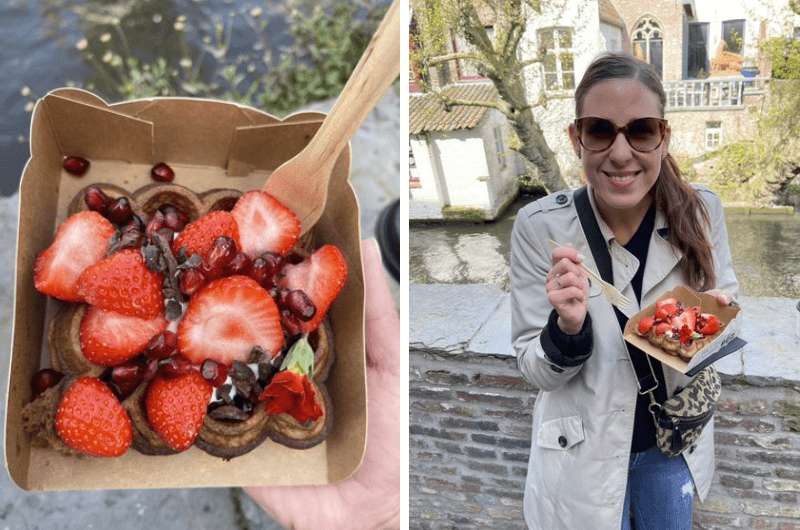
Get yours @ Otto Waffle Atelier and be ready to smile!
Watch out for tourist trap restaurants on Grote Markt. One place you shouldn’t miss is my favorite waffle place in Bruges, Otto Waffle Atelier.

Burg Square, home of Bruges’ City Hall
Burg Square is just a few steps away from Grote Markt.
Lined with more fantastic buildings and home to the Basilica of the Holy Blood and the Bruges City Hall.
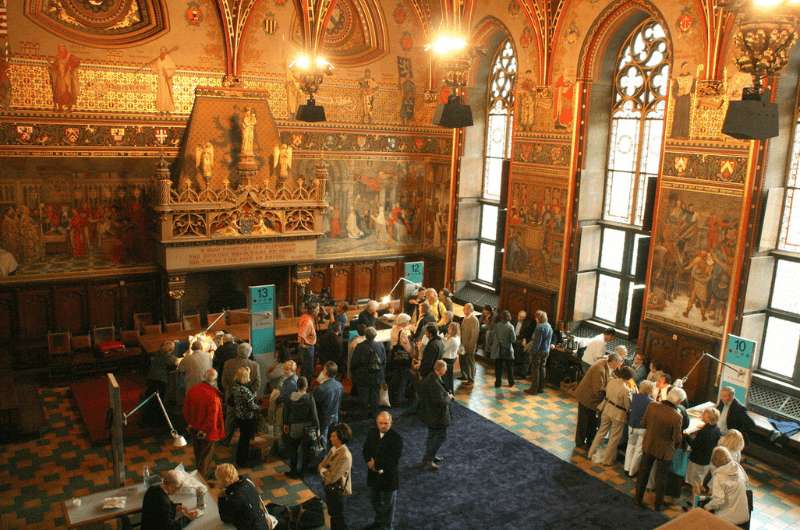
Can’t you just feel the powerful energy of the Gothic Hall?
The Bruges City Hall is one of the oldest in the Benelux countries. You can admire its gothic-ness inside and out—there is a museum in the City Hall with original artifacts and paintings depicting the history of Bruges. There are life-size portraits of important people–even Napoleon, and the Gothic Hall on the first floor is nothing short of awe-inspiring.
Visitor information:
- Price: EUR 8
- Opening hours: Daily 9:30 am–5 pm (council meetings are the last Monday of each month)
7. Historium Bruges: Is this immersive museum worth your time?
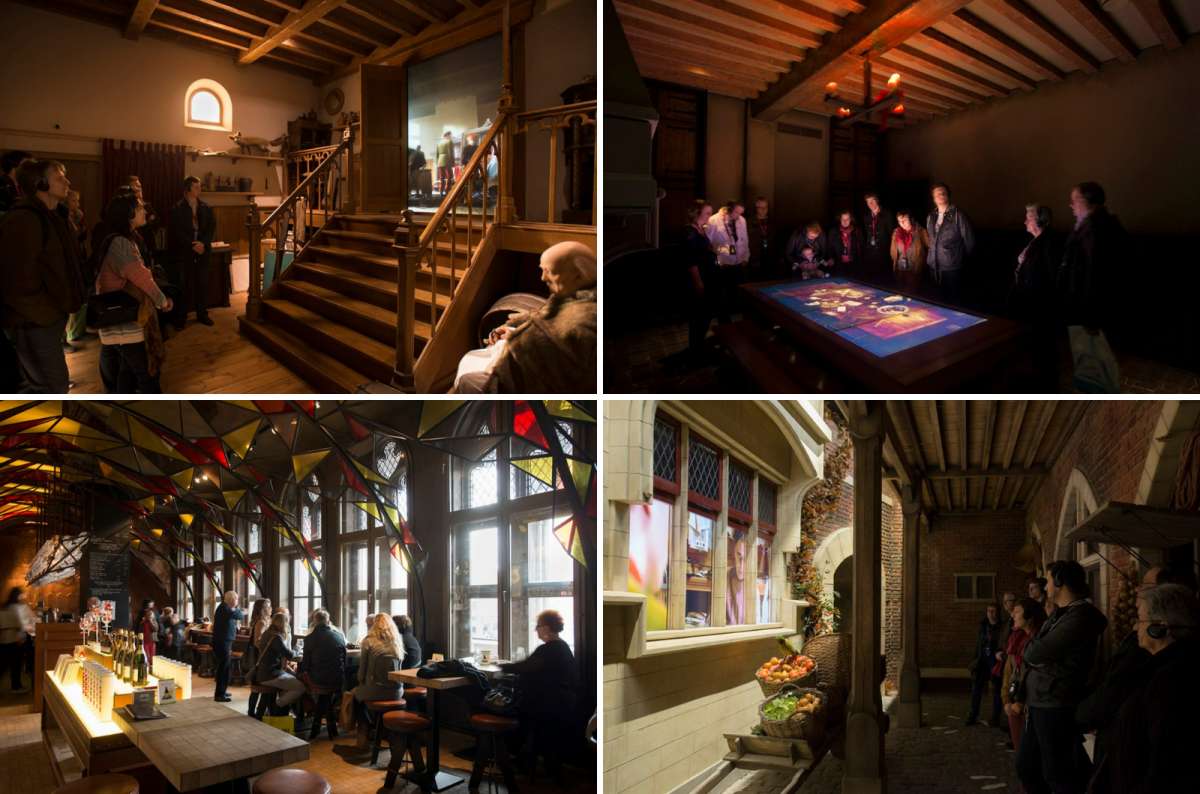
Step back in time at Historium Bruges—a beautifully immersive museum experience that brings the medieval city to life through storytelling, visuals, and even a themed bar with a view
Visitor information:
- Price: EUR 21, extras (VR, Tower) cost more—VR EUR 5, Tower EUR 10
- Opening hours: Daily from 10:00 am–6:00 pm
Right on the Grote Markt is a unique place to visit in Bruges—the Historium. This VR tour throws you into medieval Bruges, which was one of the most prosperous European cities at that time. It’s immersive, that’s for sure, sometimes even too much if you don’t like heights!
After some 8 minutes of VR, you continue with just video and audio with a creative story told by fictional characters. It’s fun, it’s high-tech. A great thing to do in Bruges if it’s raining (like lots of days in the summer)!
You need 45 minutes total in the Historium, so the price is a little steep for what you get.
Grab a beer and climb the Historium tower… maybe not in that order
You finish at the Duvelorium Grand Beer Café and there’s a balcony that overlooks the square which is nice, too.
If you have a bigger budget for Bruges, the Historium building also has a tower that you can climb for just EUR 10 more. The stair climb and the platform on top are very narrow (you can try fitting through the mock-up of the doorway in the entrance hall), but you get a 360° view from the top.
8. Choco Story Museum: Is this the best chocolate museum in Belgium?
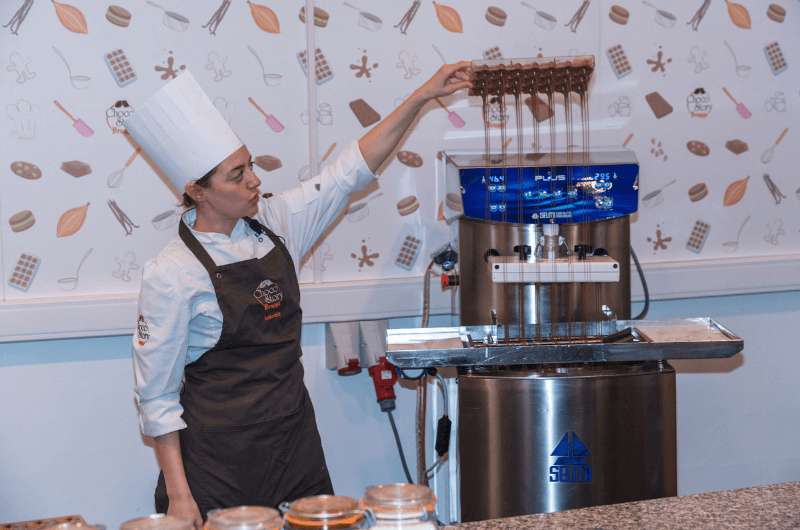
This isn’t just chocolate… it’s a lifestyle @ chocolate museum in Bruges
Visitor information:
- Price: EUR 14
- Opening hours: Daily from 10:00 am to 6:00 pm
The chocolate museum in Bruges is still shiny and new, with many a display showing the history and production of chocolate around the world. You learn a ton and taste chocolate… what’s not to love?
Tickets for Choco Story Museum do not let you jump the line
There’s the option to buy your ticket beforehand, but beware it is not a fast pass and you still stand in line with the ticket-less folks since you all need an audio guide anyway. I noticed that this made a few people a little frustrated, especially since the lines do tend to get long, especially over the weekends.
If you’re shortlisting what to visit in Bruges and chocolate is your weakness, this place makes the cut. The audio guide lets you participate in several games in Choco Story, and there is a demonstration room at the very end where you can taste unlimited chocolate.
There’s a one-way trail through the museum that’ll take you about 1.5 hours to complete.
Pro tip: The Bruges chocolate museum isn’t as hands-on as the one in Brussels, so if you’re only planning on seeing one, choose the one on my Brussels itinerary.
9. Boat canal tour in Bruges: Is this a must-do in Bruges or a tourist trap?
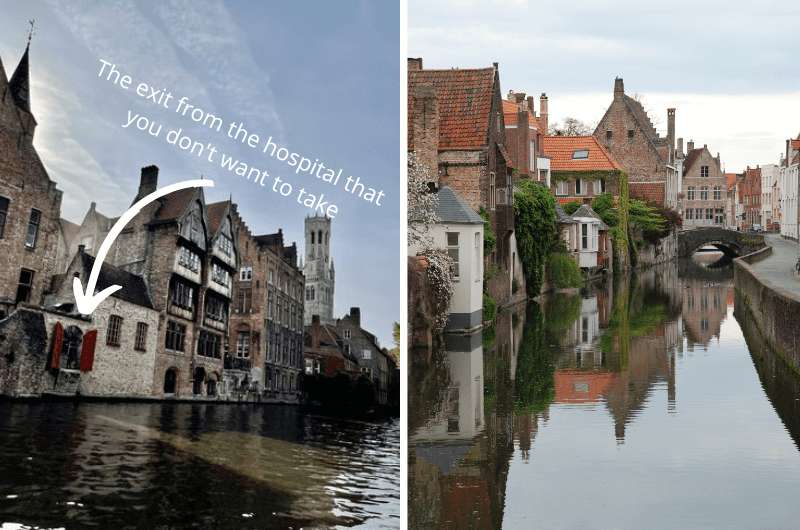
And here on the left, the cholera door
We didn’t like the Bruges boat tour as much as the one in Ghent, but it’s still a really nice way to spend 30 minutes.
A little boat takes you through the canals of Bruges and the entertaining, multi-language guide tells you all about the history and stories of Bruges. It’s a staple canal tour and definitely belongs on any list of fun things to do in Bruges.
When you pass by the back of St. John’s Hospital (now an art gallery), you’ll notice a red back door. Then you’ll notice that the back door leads directly out into the water of the canal. And your guide will proceed to tell you that that door was used to throw out dead bodies from the hospital.
It was an ingenious way that they dealt with those dead bodies that were piling up after dying from things like cholera. You know, the bacterial disease spread through contaminated water. Facepalm.

Throwing bodies of the cholera-induced dead into the city canals… I just can’t.
This is one of those classic Bruges attractions that you might roll your eyes at—until you're floating on a canal tour past centuries-old buildings thinking, 'okay fine, this is great.' It takes about 35 minutes.
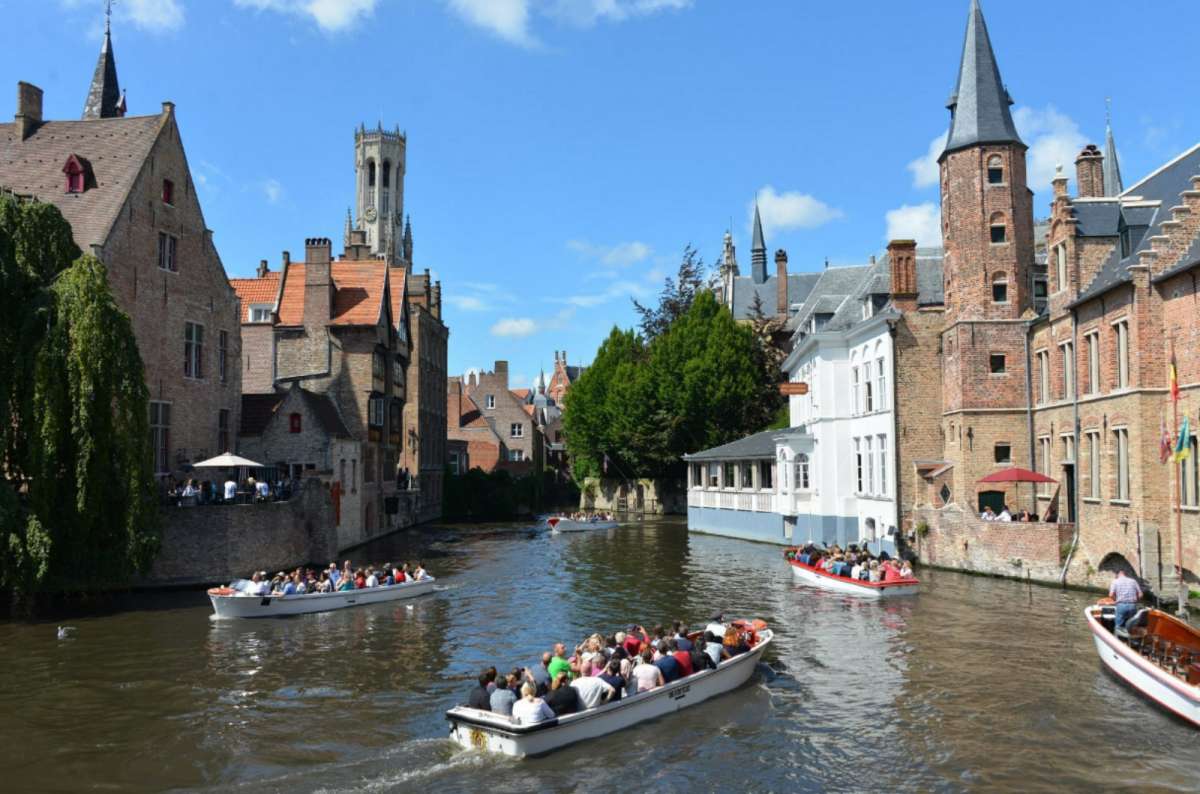
A canal cruise is one of the best ways to soak in Bruges' fairytale charm
10. Lovers’ Bridges: Where to find the most romantic places in Bruges?
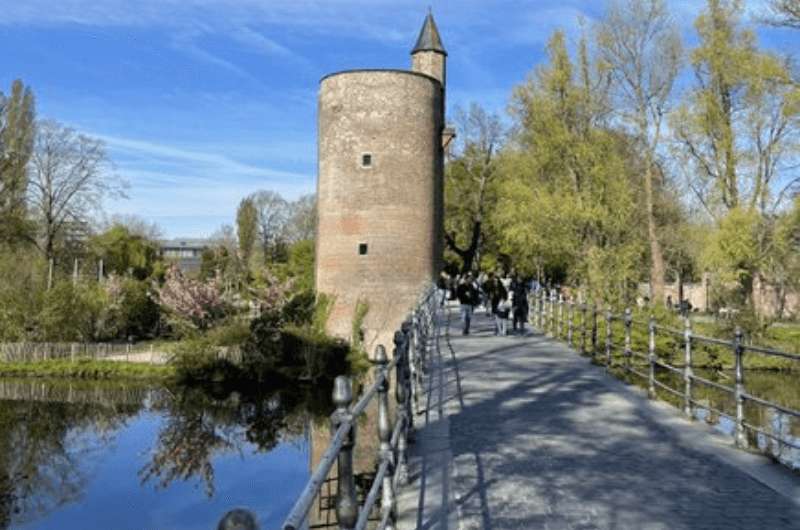
Not extremely romantic, but at least it isn’t full of those stupid padlocks that other “love bridges” of the world have fallen victim to @ Lovers’ Bridge aka Minnewaterbrug
Where is Minnewaterbrug in Bruges?
Minnewaterbrug—or Lovers' Bridge (the first one)—located in Minnewaterpark—is supposed to guarantee eternal love with whomever you cross the bridge with. I’ll let you know if it’s a myth in infinity years.
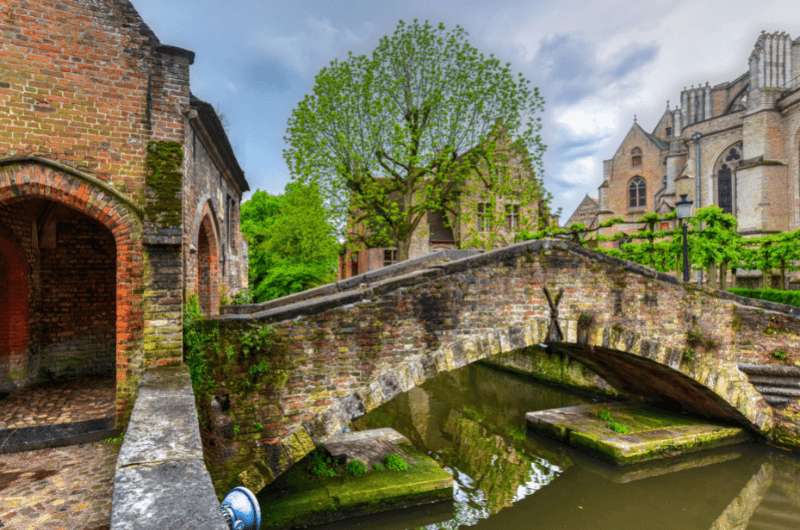
Now this is the romance level I think of when I hear “Lovers’ Bridge” @ Bonifacius Bridge
The “real” Lovers’ Bridge is Bonifacius Bridge
But what if you don’t have anyone to cross the bridge of eternal love with? No problem.
The Bonifacius Bridge, aka the Love at First Sight Bridge (but sometimes also known as Lovers’ Bridge), is supposed to have a different love trick up its sleeve. Just cross the bridge on your own, and then keep your eyes peeled, because whomever you lay your eyes on once you reach the other end will end up your lover!
It’s easily one of the most romantic places to visit in Bruges—if not the most photographed.
Fun fact: Even though Bonifacius Bridge is far superior to Lovers’ Bridge in romance level and aesthetic, it’s actually one of Bruges’ youngest bridges. It just looks old and mysterious. But it’s young and mysterious.
11. Bruge windmills: The most photogenic things to see in Bruges without crowds
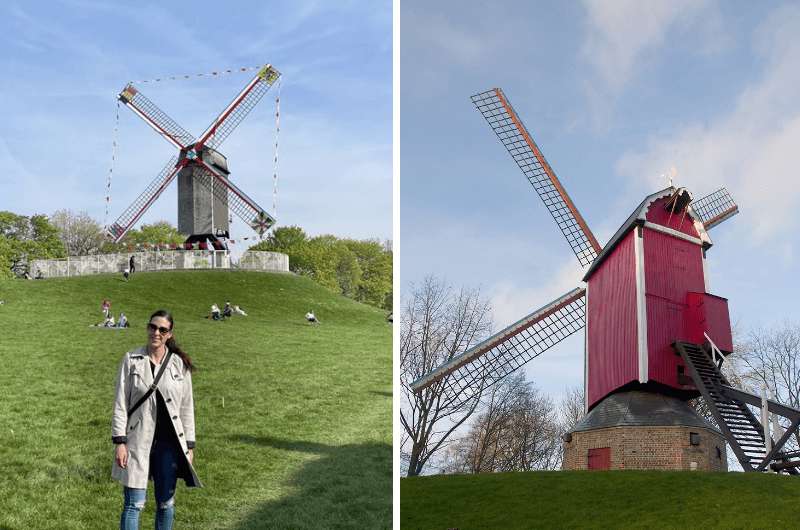
Sint-Janshuismill and Nieuwe Papegaai with the little parrot wind pointer guy just barely visible on the top
Visitor information:
- Price: EUR 5 for Sint-Janshuis Mill
- Opening hours: Sint-Janshuis Mill is the only one you can enter, daily except Mondays from 9:30 am –12:30 pm and 1:30 pm–5 pm
Thelast 4 (out of 23 original) wooden windmills of Bruges are all located between the Dampoort and the Kruispoort, which is a roughly 1 km (0.6 mile) stretch along the ramparts in the north east “corner” of the Bruges town circle.
Only one of the four windmills is in its original spot—Sint-Janshuismill, and only one is a cute pink color with a parrot on its roof—Nieuwe Papegaai. And only one, again the Sint-Janshuismill is accessible inside as well and serves as a museum. Oh, and one more! Only one of the mills is still used to grind flour. Yep, you guessed it, it’s Sint-Janshuismill.
The windmills are tiny, so if you are up for a little walk in the part, accept them as a welcome anomaly that you don’t see in your everyday life. Nothing more, nothing less.
12. Groeningemuseum, Gruuthuse, or Sint-Janshospitaal: Which Bruges art museum deserves your time?
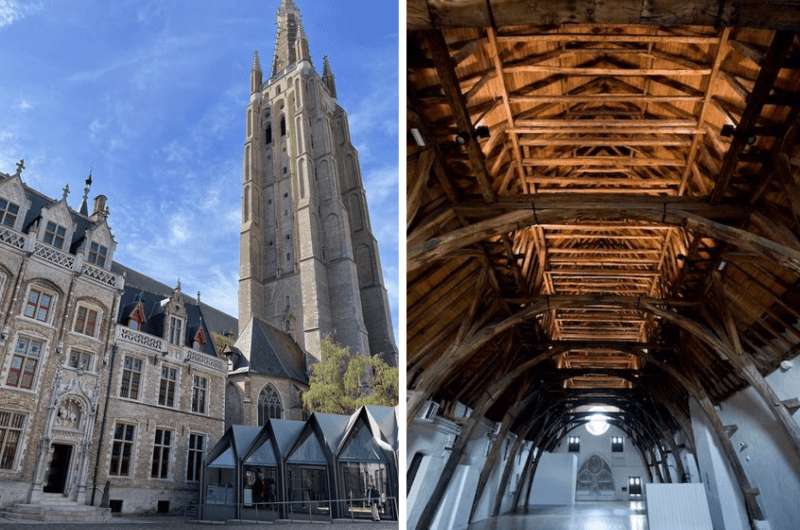
Left: Gruuthusemuseum exterior (that tall tower is not it, it’s the tower of the Church of Our Lady Bruges). Right: the oak ceiling at Sint-Janshospitaal Museum.
Visitor information:
- Price: EUR 15 each, also available is a combination ticket for the Church of Our Lady and Gruuthusemuseum for EUR 17
- Opening hours: Tuesday to Sunday 9:30 am–5:30 pm
For a small town, Bruges has a surprising number of attractions, including art museums that rank among the most interesting things to do in Bruges.I’ve narrowed it down to these three museums that are basically next to each other where you can see everything from carpets to old doctors’ tools. Yes, they are art museums.
-
The Groeninge Museum takes you through six centuries of Belgian art. I admired the details on the paintings of Flemish primitives and then enjoyes modern art by René Magritte, Roger Raveel and Raoul De Keyser.
-
Gruuthuse is the restored palace of the lords of Bruges. The Gruuthusemuseum tells visitors the story of 500 years of the city’s history through objects from tapestries and stained glass windows to lace and porcelain. They must be doing something right, because the Gruuthusemuseum was awarded Europe’s Most Welcoming Museum in 2021.
-
Sint-Janshospitaal (St. John’s Hospital) is one of the oldest preserved hospitals in Europe, so you can not only admire som old artwork but also see what it was like in a hospital centuries ago. Check out the old hospital wards and look up at the oak ceiling of the Middle Ward.
If you're trying to decide what to visit in Bruges and love quirky history or Flemish art, pick one of these and go all in.
Bonus outdoor art installation in Bruges
Very close to these museums is an outdoor statue installation called The Four Horsemen of the Apocalypse by artist Rik Poot. They are to represent Revolution, War, Hunger and Death, and well, it’s not exactly adorable. That Hunger guy could really use a hamburger.
13. Underrated Bruges attractions: Are Bruges’ city gates and old bridges worth the walk?
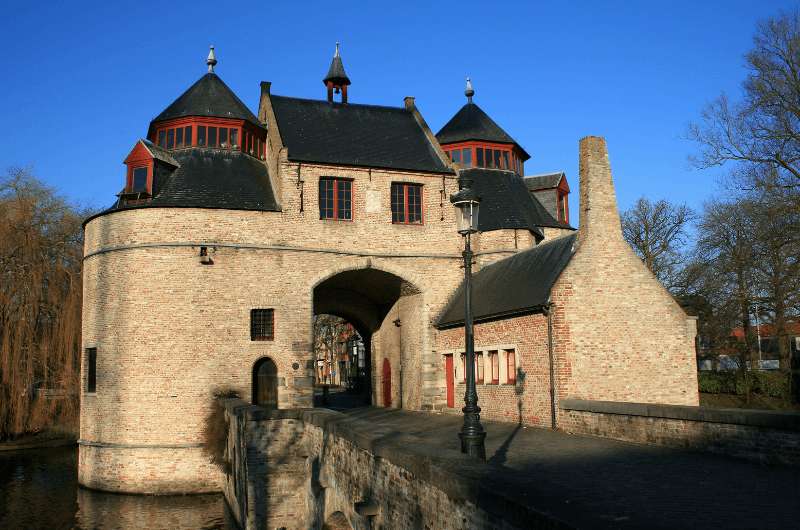
Ezelpoort means Donkey Gate
Visit Bruges city gates
Four city gates in Bruges have been preserved: Gentpoort, Kruispoort, Ezelpoort and Smedenpoort. The last two are water gates, meaning they sit directly on a bridge over the river—very photogenic, very Bruges. Worth seeing one or two of them, no need to chase them all down.
Did you know the city is below water level?
A fun fact about Bruges: the city center itself is 1 meter below river level. So yeah, those cute little lockhouses you’ll see were essential to keeping Bruges from turning into a soggy mess.
One of the nicest examples is the Sashuis, a brick structure you’ll notice in the south of town, near Minnewasserpark’s Lovers’ Bridge. Once an actual water control station, now just quietly standing around looking great in photos.
Bruges‘ bridges
There are numerous bridges in Bruges that connect the maze of canals—some modern, some old, and honestly, all pretty nice. You’ll see plenty of them during your day in Bruges without even trying.
There are walkways, stone bridges, and a mix of drawbridges scattered around the city. I don’t know why, but canals and bridges always make a place feel nice. A must-do in Bruges, but requires zero effort.
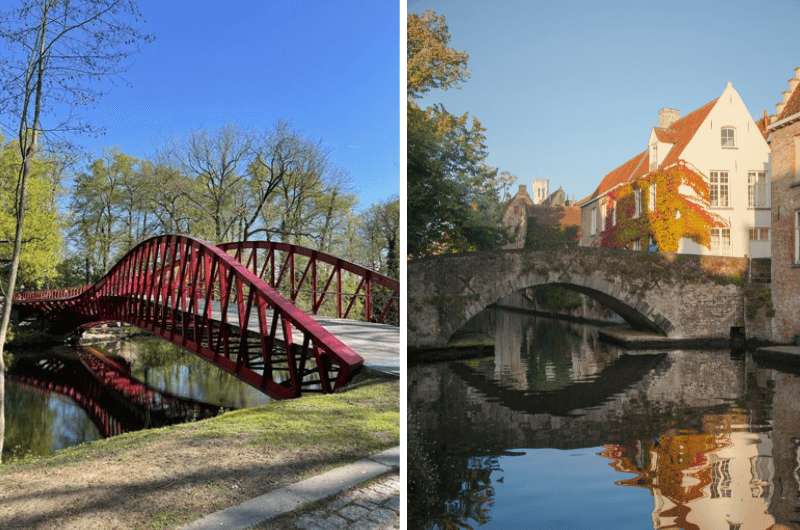
Some are modern, some are old, and all are nice
Is Bruges worth it?
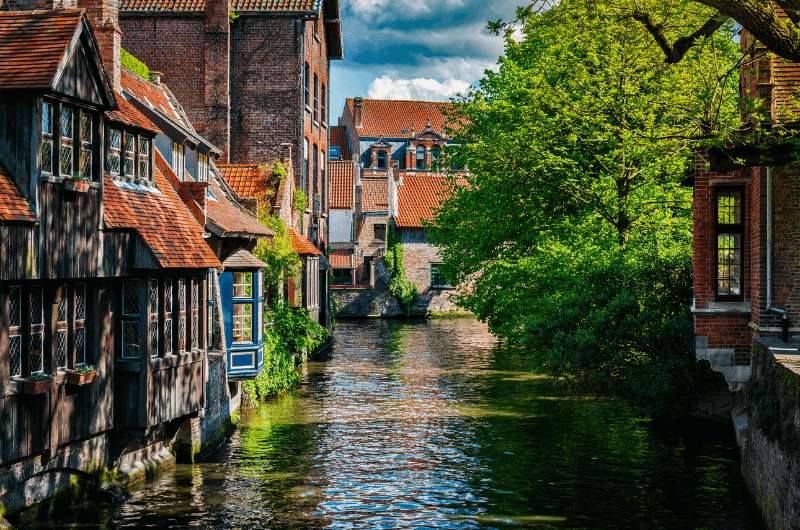
Yes, you want to go to Bruges
Yes, even if you’ll complain about the crowds. They’re there for a reason. Bruges is a solidly pleasant place with pretty architecture and many canals that add to the charm. You can see it in a day, but your day will be packed with the best of Bruges.
Bruges travel tips: How to make the most of your day:
-
Buy your tickets to the Belfry in advance and be on time. Otherwise you have almost zero chance of getting in.
-
Stay overnight if you want to experience the best of Bruges without day trippers. There are A LOT of them. Hotel Dukes' Palace is a 5-star stunner with stained glass windows in the rooms. Relais Bourgondisch Cruyce is right on the canal.
-
The train from Brussels takes only 1 hour. Belgium is one of the rare countries where I don’t recommend renting a car because the trains are more convenient and parking in Bruges is limited and expensive.
-
Plan ahead so you don’t waste time deciding what to see in Bruges last minute. Your feet (and sanity) will thank you.
-
There’s no nightlife in Bruges. It’s really first and foremost a popular day trip from Brussels, so after the last tourist buses leave around 6 pm, Bruges suddenly gets very quiet.
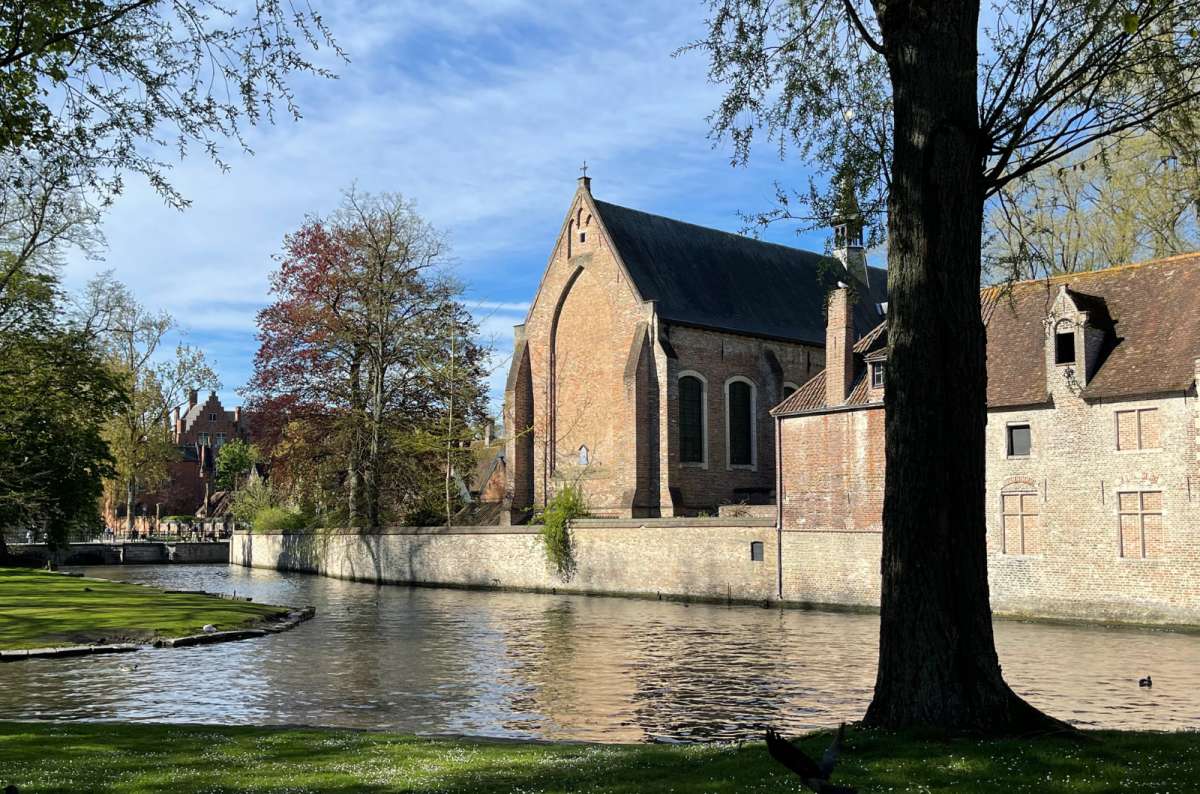
The quieter, charming side of Bruges you won’t want to miss when exploring what to see in Bruges
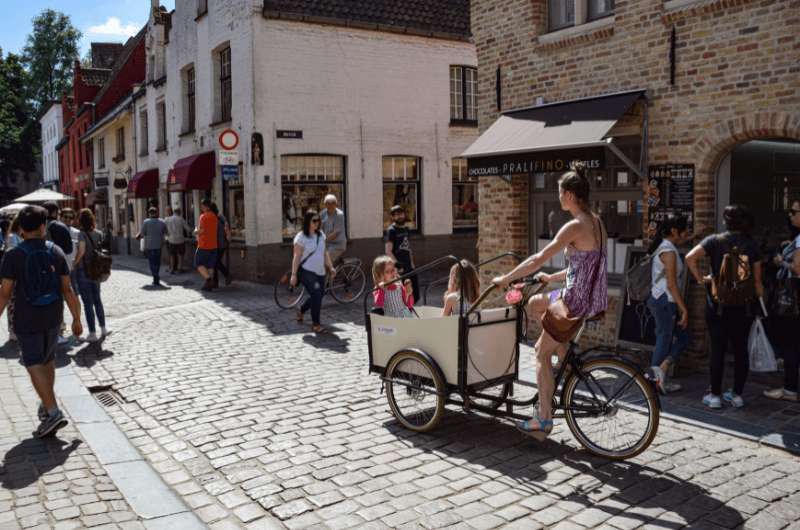
Bruges is all day-life and no nightlife
How do you pronounce “Bruges”?
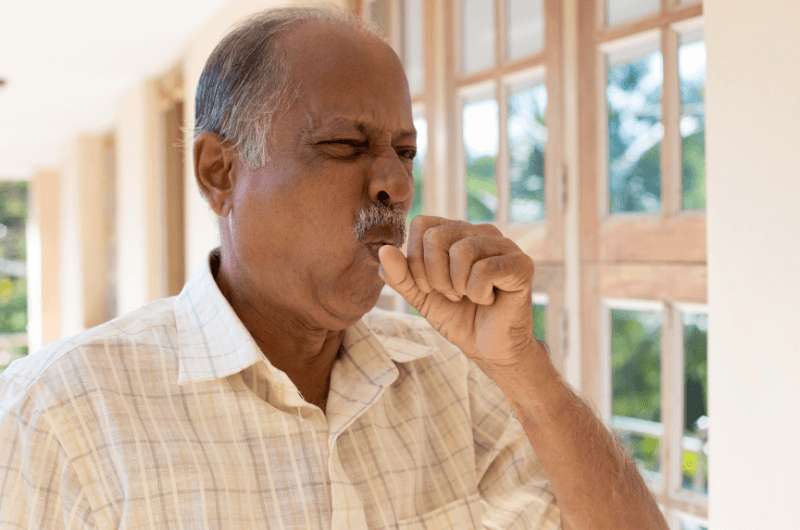
A man pronouncing “Brugge” in Flemish
Let’s get one thing straight. How do you pronounce Bruges? In English, you say [broozh]. The ‘s’ at the end is silent. In Flemish, the name of the city is Brugge and sounds like someone clearing their throat.
You might also be interested in reading:
Sometimes, all you need to do is take the first step... I've filtered out the best hotels in Bruges for you
Save it for yourself to come back to later, or share with your friends on social media!
I've already planned your ititnerary for the trip, complete with my travel tips.
This post contains affiliate links. If you make a booking through one of my links, I may earn a small commission—at no additional cost to you. Thank you for your support!
Quick list: the best places to visit in Bruges (at a glance)
Tourist map of Bruges attractions and train station
1. Bruges Beer Experience: My absolute favorite thing to do in Bruges
2. De Halve Maan brewery tour: Is Bruges’ oldest brewery worth the hype?
3. Bruges Belfry: Should you climb Bruges' most famous tower?
4. Basilica of the Holy Blood: What’s inside Bruges’ most mysterious church?
5. The churches of Bruges: Is this the most beautiful church in Bruges?
6. Market Square, Burg Square & Bruges City Hall: What to see in Bruges’ city center?
7. Historium Bruges: Is this immersive museum worth your time?
8. Choco Story Museum: Is this the best chocolate museum in Belgium?
9. Boat canal tour in Bruges: Is this a must-do in Bruges or a tourist trap?
10. Lovers’ Bridges: Where to find the most romantic places in Bruges?
11. Bruge windmills: The most photogenic things to see in Bruges without crowds
12. Groeningemuseum, Gruuthuse, or Sint-Janshospitaal: Which Bruges art museum deserves your time?
13. Underrated Bruges attractions: Are Bruges’ city gates and old bridges worth the walk?
Bruges travel tips: How to make the most of your day:




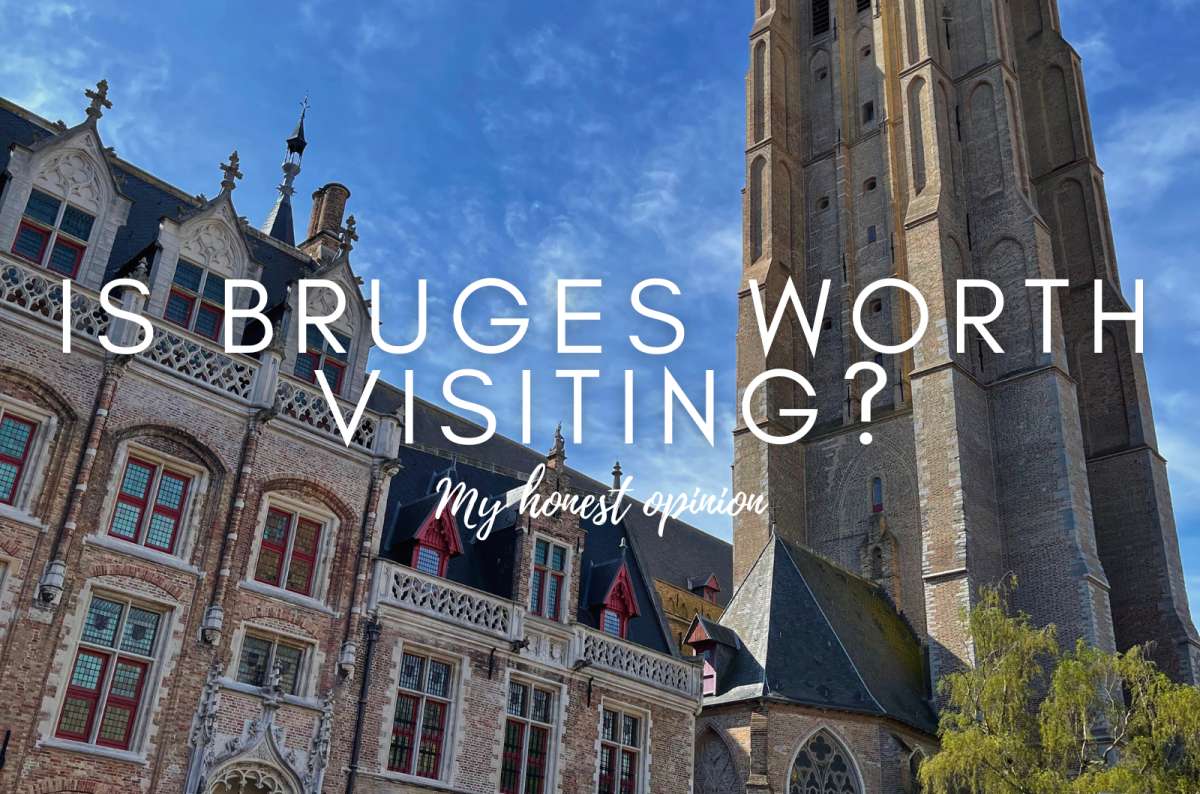
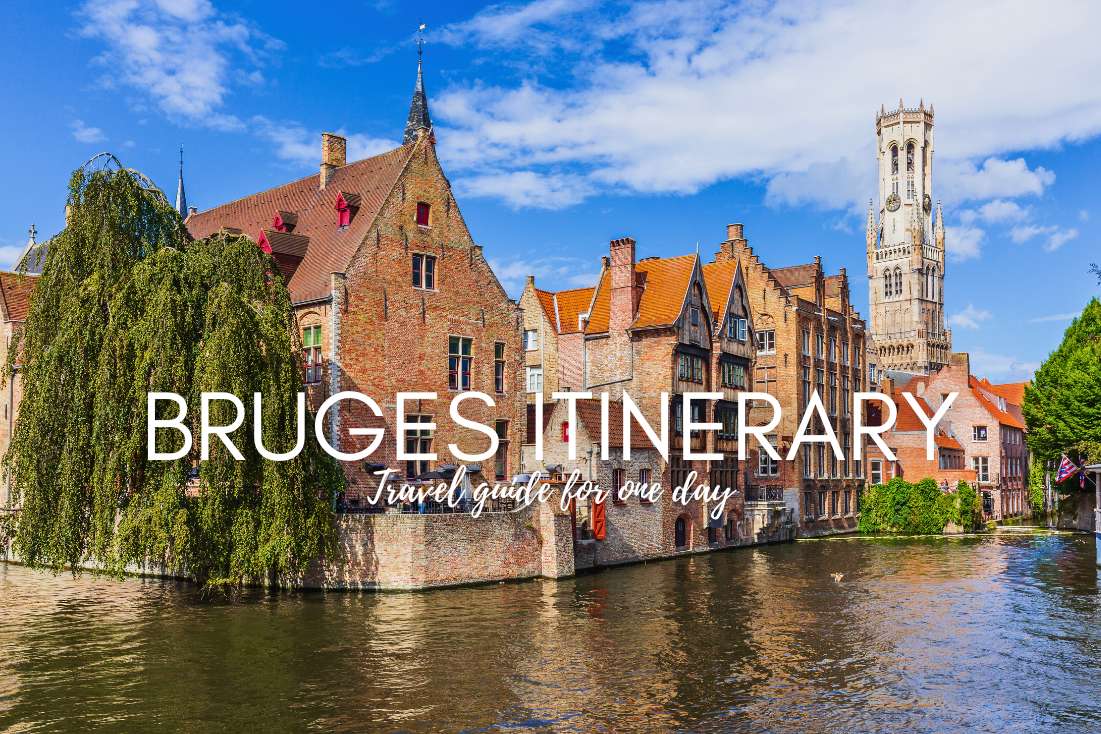
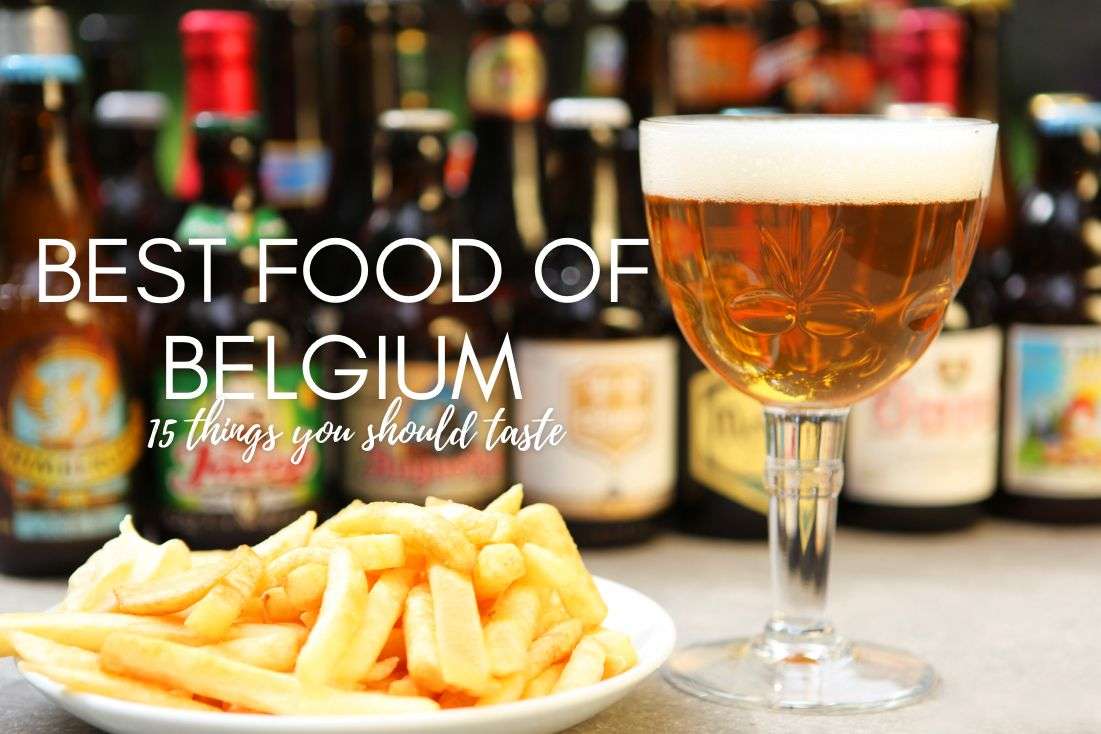



Comments | Thoughts? Give us a shout!